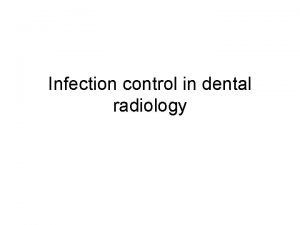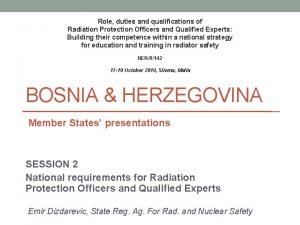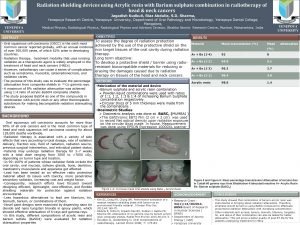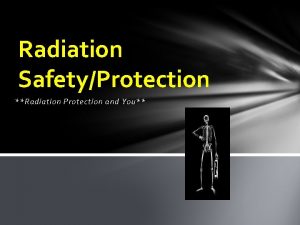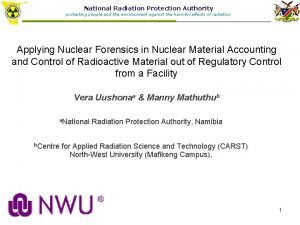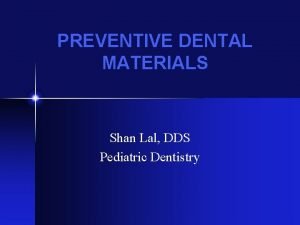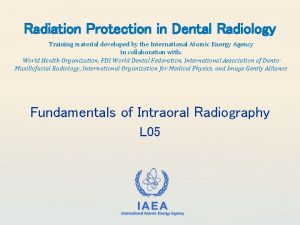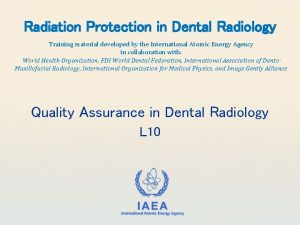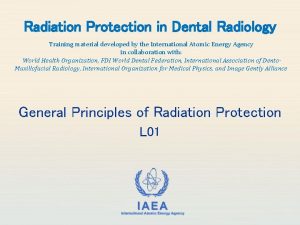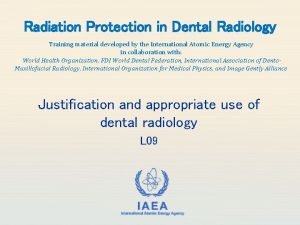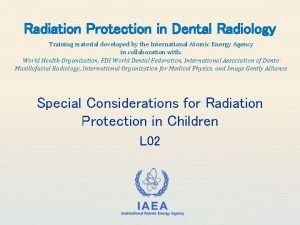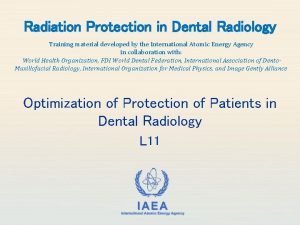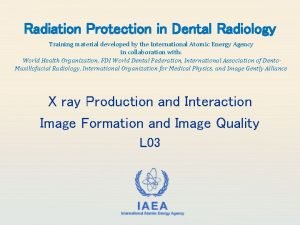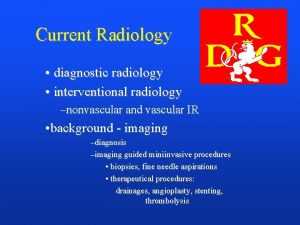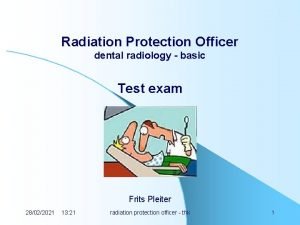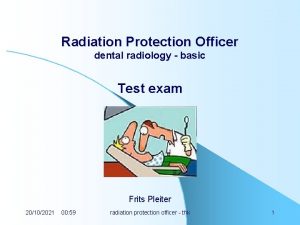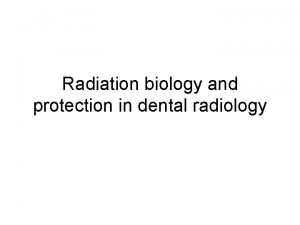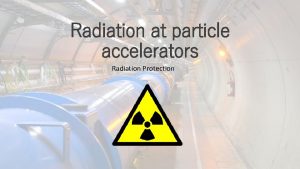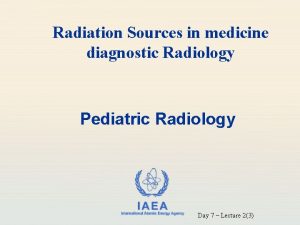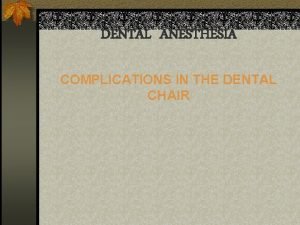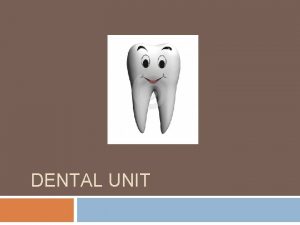Radiation Protection in Dental Radiology Training material developed





















- Slides: 21

Radiation Protection in Dental Radiology Training material developed by the International Atomic Energy Agency in collaboration with: World Health Organization, FDI World Dental Federation, International Association of Dento. Maxillofacial Radiology, International Organization for Medical Physics, and Image Gently Alliance Fundamentals of Extraoral Projectional Radiography L 07 IAEA International Atomic Energy Agency

Educational Objectives • Differentiate between lateral cephalometric, posteroanterior cephalometric, submentovertex, occipito-mental and occipitofrontal projections, in terms of positioning of patient & image receptor and respective clinical applications IAEA Radiation Protection in Dental Radiology L 07 Fundamentals of Extraoral Projectional Radiography 2

Overview of most common techniques LATERAL CEPH IAEA SUBMENTOVERTEX OCCIPITOMENTAL PA CEPH OCCIPITOFRONTAL Radiographs courtesy of P. Pittayapat, Chulalongkorn Univ. Radiation Protection in Dental Radiology L 07 Fundamentals of Extraoral Projectional Radiography 3

Planes used for patient positioning A. Frankfurt Horizontal Plane • Superior border of external auditory meatus • Infra-orbital rim B. Canthomeatal line • Center of external auditory canal • Outer canthus of eye C. Alar-Tragus line • Alar of nose • Center of tragus IAEA Radiation Protection in Dental Radiology B A C L 07 Fundamentals of Extraoral Projectional Radiography 4

Image receptors in EOR • Film & different types of digital receptors • Film: in combination with intensifying screens (as in panoramic, but not intra-oral) (see L 04) • Digital receptors (L 04): • Photostimulable phosphor (PSP) • CCD, CMOS • TFT IAEA Radiation Protection in Dental Radiology L 07 Fundamentals of Extraoral Projectional Radiography 5

Skull radiography units • Cephalometric radiography units • Focus-receptor distance 150 -200 cm • Typically combined with panoramic units (or with CBCT and pano, i. e. 3 -in-1) IAEA Radiation Protection in Dental Radiology L 07 Fundamentals of Extraoral Projectional Radiography 6

Skull radiography units • Other skull units • Isocentric: most widely available; receptor and beam always perpendicular • Lysholm: not widely used nowadays R. Schulze IAEA Radiation Protection in Dental Radiology L 07 Fundamentals of Extraoral Projectional Radiography 7

Anti-scatter grids in EOR • Grid aligned with primary X ray beam: primary X rays pass through holes, majority of scatter will be absorbed • Higher (~2 x) patient dose needed: only use when high contrast is required (e. g. normally not needed for lateral ceph) Scatter grid for a parallel-beam geometry. A grid of lead strips ( ) is placed in front of the image receptor. Scattered radiation ( ) which is not parallel to the primary X rays ( ) will be absorbed by the grid. Only a small fraction of scattered radiation will pass through the grid ( ) IAEA Radiation Protection in Dental Radiology L 07 Fundamentals of Extraoral Projectional Radiography 8

Cephalometric radiography • Used to evaluate the relationship between anatomical points at the teeth, jaws and skull bones • Orthodontics, maxillofacial surgery • Covers more than maxillofacial area: should always be evaluated for any head & neck pathology (see step-wise evaluation White & Pharoah (2014)) • Lateral and postero-anterior (PA) radiograph • Acquired at a relatively long source-to-patient distance IAEA Radiation Protection in Dental Radiology L 07 Fundamentals of Extraoral Projectional Radiography 9

Lateral cephalometric radiograph • Most common extraoral projectional • • radiograph used in dentistry Covers most of the head Head in ‘natural position’ (vertical marker added as reference), Frankfort plane horizontal Image receptor parallel to sagittal plane Mouth closed, centric occlusion (i. e. biting back teeth together), lips relaxed IAEA Radiation Protection in Dental Radiology P. Pittayapat, Chulalongkorn Univ. L 07 Fundamentals of Extraoral Projectional Radiography 10

Lateral cephalometric radiograph • Wedge filter used in anterior part of beam: reduces exposure to anterior soft tissue, enabling it to be visualized • Slight difference in magnification between anatomical structures on tube & detector side • Difference in magnification increases with distance to Larger Smaller midsagittal plane magnification IAEA Radiation Protection in Dental Radiology L 07 Fundamentals of Extraoral Projectional Radiography 11

P-A cephalometric radiograph • Second most common • Facial asymmetries • Orthognatic surgery • X ray tube behind the patient’s head, image receptor in coronal plane • Patient orientation: natural head position, Frankfort plane perpendicular to image receptor P. Pittayapat, Chulalongkorn Univ. IAEA Radiation Protection in Dental Radiology L 07 Fundamentals of Extraoral Projectional Radiography 12

Cephalometric tracing & landmarks • Radiograph can be traced (digitally or on paper) for • • cephalometric analysis and to evaluate changes during treatment through superimposition Landmarks: specific anatomical points Can be used to evaluate angles and planes Different types of analysis used • e. g. Steiner, Ricketts, Mc. Namara Similar to lateral ceph: entire image should be evaluated IAEA Radiation Protection in Dental Radiology L 07 Fundamentals of Extraoral Projectional Radiography 13

Cephalometric tracing & landmarks Lateral ceph Tracing (Ricketts) Courtesy of K. de Faria Vasconcelos IAEA Radiation Protection in Dental Radiology L 07 Fundamentals of Extraoral Projectional Radiography 14

Occipito-mental projection • A. k. a. Waters’ projection • Beam angled (37 -45°) to orbito-meatal line • Visualizes: Maxillary sinuses (primarily), orbits, frontal/ethmoidal sinus, zygomaticofrontal suture, nasal cavity, sphenoidal sinus (if mouth open) D. M. Brasil IAEA Radiation Protection in Dental Radiology L 07 Fundamentals of Extraoral Projectional Radiography 15

Occipito-mental projection Examples with closed mouth IAEA P. Pittayapat Radiation Protection in Dental Radiology D. M. Brasil L 07 Fundamentals of Extraoral Projectional Radiography 16

Submentovertex projection • Acquired with neck in maximal extension, with image receptor on top of the head (parallel to orbito-meatal plane) • X-ray beam: perpendicular to cantho-meatal line • Visualizes: • Base of the skull (e. g. foramina) • Sphenoid sinuses • Mandibular condyles • Zygomatic arch IAEA Radiation Protection in Dental Radiology P. Pittayapat, Chulalongkorn Univ. L 07 Fundamentals of Extraoral Projectional Radiography 17

Occipito-frontal with cranial angulation • A. k. a. Reverse Towne’s projection • Fracture of condylar neck, medially displaced condyle, posterolateral wall of maxillary antrum • Patient position: canthomeatal line at 15 -30° to image receptor, mouth open as wide as possible IAEA Radiation Protection in Dental Radiology P. Pittayapat, Chulalongkorn Univ. L 07 Fundamentals of Extraoral Projectional Radiography 18

Other projections • • • PA skull (similar to PA ceph) PA jaws Oblique PA Lateral oblique Mandibular body Mandibular ramus R. Schulze Lateral oblique radiograph IAEA Radiation Protection in Dental Radiology L 07 Fundamentals of Extraoral Projectional Radiography 19

Note: positioning • For certain radiographic projections, slightly different positioning criteria may exist than those selected for this training material • e. g. PA cephalometric radiograph: Frankfort plane perpendicular to image receptor vs. orbitomeatal line perpendicular to image receptor • e. g. occipito-frontal projection: mouth open vs. mouth closed IAEA Radiation Protection in Dental Radiology L 07 Fundamentals of Extraoral Projectional Radiography 20

References Erkan M et al. (2012) Reliability of four different computerized cephalometric analysis programs. Eur J Orthod. ; 34: 318 -21. Jung PK et al. (2015) Comparison of cone-beam computed tomography cephalometric measurements using a midsagittal projection and conventional two-dimensional cephalometric measurements. Korean J Orthod. ; 45: 282 -8. White SC & Pharaoh MJ. (2014) Oral Radiology: Principles and Interpretation. 7 thed. St. Louis: CV Mosby Company. For more projections and detailed positioning and evaluation guidelines: Stewart Whitley A, Jefferson G, Holmes K, Sloane C, Anderson C, Hoadley G. (2015) Clark’s Positioning in Radiography. 13 th ed. CRC Press: Taylor&Francis Group. IAEA Radiation Protection in Dental Radiology L 07 Fundamentals of Extraoral Projectional Radiography 21
 Pa dental radiology ce requirements
Pa dental radiology ce requirements Radiographic errors in dentistry ppt
Radiographic errors in dentistry ppt Infection control in dental radiology
Infection control in dental radiology Radiation protection officer qualifications
Radiation protection officer qualifications Barium sulphate board for radiation protection
Barium sulphate board for radiation protection Cardinal principles of radiation protection
Cardinal principles of radiation protection National radiation protection authority namibia
National radiation protection authority namibia Circuit training disadvantages
Circuit training disadvantages Auxiliary dental material
Auxiliary dental material What are preventive dental material?
What are preventive dental material? Thermophysical properties of dental materials
Thermophysical properties of dental materials Auxiliary dental material
Auxiliary dental material Scaffold competent person training ppt
Scaffold competent person training ppt Ladder outline
Ladder outline Child protection training materials
Child protection training materials Child protection awareness training
Child protection awareness training Geometrical symbols
Geometrical symbols Material price variance formula
Material price variance formula What is cultural relativism
What is cultural relativism Material and non material culture examples
Material and non material culture examples Non material culture examples
Non material culture examples Useful to harmful materials
Useful to harmful materials


